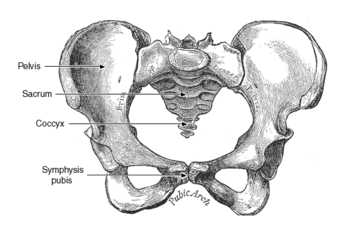Symphysis pubis dysfunction

Symphysis Pubis Dysfunction (SPD) is a condition that causes excessive movement of the pubic symphysis, either anterior or lateral, as well as associated pain, possibly because of a misalignment of the pelvis. Most commonly associated with pregnancy and childbirth,[1][2] it is diagnosed in approximately 1 in 300 pregnancies, although some estimates of incidence are as high as 1 in 50.[3]
SPD is associated with pelvic girdle pain and the names are often used interchangeably.
Symptoms
The main symptom is usually pain or discomfort in the pelvic region. This will probably be centered on the joint at the front of the pelvis (the pubic symphysis). Some sufferers report being able to hear the lower back and hip joints, the sacroiliac, clicking or popping in and out as they walk or change position. Sufferers frequently also experience pain in the lower back, hips, groin, lower abdomen, and legs. The severity of the pain can range from mild discomfort to extreme and prolonged suffering.[4] There have been links between SPD and depression on account of the associated physical discomfort.[5][6][7] Sufferers may walk with a characteristic waddling gait and have difficulty climbing stairs, problems with leg abduction and adduction, pain when carrying out weight bearing activities, difficulties carrying out everyday activities, and difficulties standing.[8]
Any untreated or not taken care condition can lead to disabilities or physical damage.
Diagnosis
A diagnosis is not usually made from the symptoms alone, after pregnancy, MRI scans, x-rays and ultrasound scanning are sometimes used. Women initially report the condition to an obstetrician, general practitioner, physiotherapist or an osteopath. On seeing a health professional, women should expect to receive a thorough physical examination to rule out other lumbar spine problems, such as a prolapsed disc, or other conditions such as urinary tract infections and Braxton Hicks contractions.
Treatment and management
While there is no evidence in the medical literature to support any particular treatment, the mainstay of currently accepted treatments are the use of elbow crutches, pelvic support devices and prescribed pain relief. The majority of problems will resolve spontaneously after delivery.[9] There are studies that show reduction of pain and dysfunction with conservative chiropractic care.[10]
In some cases, patients may also receive advice on pelvic floor and core stability exercises. In very extreme cases surgery is considered after pregnancy to stabilise the pelvis, but success rates are very poor.[11]
Everyday living
Typical advice usually given to women includes avoiding strenuous exercise, prolonged standing, vacuum cleaning, stretching exercises and squatting. Women are also frequently advised to:
- Brace the pelvic floor muscles before performing any activity which might cause pain
- Rest the pelvis
- Sit down for tasks where possible (e.g. preparing food, ironing, dressing)
- Avoid lifting and carrying.
- Avoid stepping over things.
- Avoid straddle movements especially when weight bearing.
- Bend the knees and keep the legs 'glued together' when turning in bed and getting in and out of bed.
- Place a pillow between the legs when in bed or resting.
- Avoid twisting movements of the body.
If the pain is very severe, using elbow crutches will help take the weight off the pelvis and assist with mobility. Alternatively, for more extreme cases a wheelchair may be considered advisable.
Pharmacological interventions
It is not usually considered advisable to take anti-inflammatory medication in pregnancy, which makes SPD a particularly difficult condition to manage. Women are therefore typically often prescribed 30 mg or 60 mg of codeine phosphate to be taken in conjunction with 1,000 mg paracetamol, four times a day. However codeine phosphate is an opiate, and as such carries a risk of depressed respiration in the newborn baby if it is taken near the time of the birth. Therefore, it is usually considered advisable to cease taking codeine phosphate 2–4 weeks before the estimated due date, as advised by a medical professional. If this is not possible, then a planned hospital birth is recommended. Other medications in common use include oral morphine.
See also
- Diastasis symphysis pubis, the separation of normally joined pubic bones
- Osteitis pubis, inflammation of the pubic symphysis
- Pelvic girdle pain, Pregnancy related Pelvic Girdle Pain
References
- ↑ http://www.dailymail.co.uk/health/article-2593673/Pelvic-pain-years-childbirth-Pregnant-women-told-ignore-pelvic-pain-lead-long-term-damage.html
- ↑ http://www.dailymail.co.uk/health/article-389319/Giving-birth-left-wheelchair.html
- ↑ http://www.whattoexpect.com/pregnancy/symptoms-and-solutions/symphysis-pubis-dysfunction
- ↑ http://www.pelvicpartnership.org.uk/3208.html
- ↑ http://www.acpwh.org.uk/docs/ACPWH-PGP_HP.pdf
- ↑ http://www.pelvicpartnership.org.uk
- ↑ http://onlinetog.org/cgi/reprint/8/3/153.pdf
- ↑ http://www.acpwh.org.uk/docs/ACPWH-PGP_HP.pdf
- ↑ National Institute for Health and Clinical Excellence Guideline 62 Antenatal Care http://www.nice.org.uk/nicemedia/pdf/CG62FullGuidelineCorrectedJune2008.pdf
- ↑ Howell, Emily R. (2012-06-01). "Pregnancy-related symphysis pubis dysfunction management and postpartum rehabilitation: two case reports". The Journal of the Canadian Chiropractic Association. 56 (2): 102–111. ISSN 0008-3194. PMC 3364059
 . PMID 22675223.
. PMID 22675223. - ↑ http://www.acpwh.org.uk/docs/ACPWH-PGP_HP.pdf
External links
Further reading
- Jaim, S et al. (2006) RCOG Review: Symphysis Pubis Dysfunction: A Practical Approach to Management (pdf) Accessed 19 January 2009
- Pelvic Partnership (2008) About SPD: A leaflet about Symphysis Pubis Dysfunction and its Management (pdf) Accessed 19 January 2009
- Crichton, Margaret A. and Wellock, Vanda K. (2007) Understanding pregnant women's experiences of symphysis pubis dysfunction: the effect of pain (Royal College of Midwives Evidence Based Midwifery) Accessed 27 January 2009
- BBC Radio 4 - Woman's Hour Health Archive, 21 May 2004 Accessed 27 January 2009
- Wainwright, M. et al. (2003) "Symphysis Pubis Dysfunction: Improving the Service" in British Journal of Midwifery Vol 11 No 11 Accessed 27 January 2009
